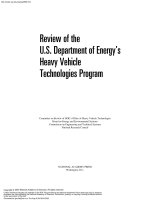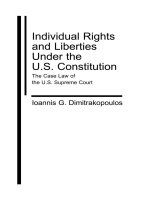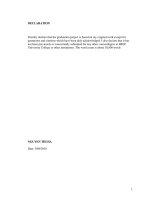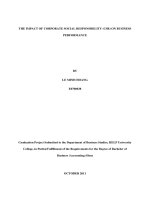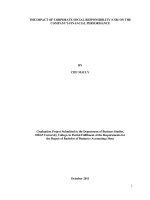Impact of the 1968 Tet Offensive on Re-shaping the U.S. war strategy: A view fromamerican war generals and researchers
Bạn đang xem bản rút gọn của tài liệu. Xem và tải ngay bản đầy đủ của tài liệu tại đây (230.95 KB, 9 trang )
Hue University Journal of Social Science and Humanities
ISSN 2588–1213
Vol. 127, No. 6B, 2018, Tr. 29–37, DOI: 10.26459/hueuni-jssh.v127i6B.4649
IMPACT OF THE 1968 TET OFFENSIVE ON RE-SHAPING THE
U.S. WAR STRATEGY: A VIEW FROMAMERICAN WAR
GENERALS AND RESEARCHERS
Trinh Thi Dinh*
University of Sciences, Hue University
77 Nguyen Hue St., Hue, Vietnam
Abstract. Exactly half a century has passed since the 1968 Tet Offensivewas undertaken, but its size, the
implementation of its activities, and its impact on the course of Vietnam War still attract the attention of a
great number of researchers. Based on papers published by Pentagon and also on publications by
American researchers, this article explores why and how the American Administration re‐shaped their
war strategy in the aftermath of the Tet Offensive.
Keywords.Tet Offensive, impact, American Administration, war strategy, re‐shaping
1. Introduction
The Mau Than General Offensive and Uprising began on the night of 30th January 1968,
which coincided with the Lunar New Year’s Eve. ThePeople’s Army of Vietnam (PAVN) and
National Liberation Front (NLF) forces (hereafter Vietnamese revolutionary forces) launched a
wave of simultaneous attacks on South Vietnamese and American military bases in major cities,
towns and the countryside throughout South Vietnam. The American press reported that 5 of
the 6 South Vietnamese autonomous cities, including Saigon and Hue; 36 of the 44 provincial
capitals and 64 of the 245 district capitals were attacked, and Hue city was in the hands of the
revolutionary forces for more than three weeks. The fighting, as assessed in The New York
Times dated 31st January 1988, was the heaviest and most sustained of the Vietnam War. The
Offensive, as acknowledged by the American press, despite its heavy casualties for the
Vietnamese revolutionary forces and their failure to inspire widespread uprising among the
* Corresponding:
Submitted:15–01–2018; Revised: 15–06–2018; Acceptted: 21–07–2018.
Trinh Thi Dinh
Vol. 127, No. 6B, 2018
South Vietnamese people, proved to be a strategic success for the North Vietnamese and also
“the watershed event of the U.S. war in Vietnam”.1
This kind of assessment appeared to be logically argued as it was based on the whole
process of United States’ (US) intervention in Vietnam and the making of their strategic plans
prior and after the Tet Offensive.
2. The US strategic plans for Vietnam prior Tet Offensive
One month after the first US combat forces landed in Da Nang on 8th March 1965,
President Johnson had commissioned U.S. forces on the ground war. As the U.S. goal was to
protect South Vietnam from the Communists and to secure the South Vietnamese regime, a
“three‐phase sustained campaign” was set from 1965.2 Phase 1 visualized the commitment of
the U.S. and allied forces “necessary to halt the losing trend by 1965”. Its tasks included
securing allied military bases, defending major political and population centers, and
strengthening the army of South Vietnam. In Phase 2, General Westmoreland – chief
commander of the US forces in Vietnam – sought to resume the offensive to “destroy enemy
forces” and reinstitute “rural construction activities.” In this phase, planned to begin in 1966,
the American forces would “participate in clearing, securing, and reserving reaction and
offensive operations as required to support and sustain the resumption of pacification.” Finally,
in Phase 3, the Military Assistance Command in Vietnam (MACV) would oversee the “defeat
and destruction of the remaining enemy forces and base areas”. It is important to note that
Westmoreland’s plan included the term “sustained campaign”. By setting this, Westmoreland
was determined that US forces were engaged in a war of annihilation which would quickly
destroy the Vietnamese revolutionary forces.
From the beginning of 1965, MACV began “Search and Destroy” operations in South
Vietnam; simultaneously, from March 1965 the U.S. began the Rolling Thunder air strike at
ammunition depots and naval bases in North Vietnam. Both “Search and Destroy” operations
in the South and Rolling Thunder air strikes in the North were integral components of
Westmoreland’s “War of Attrition”. Westmoreland even likened “search and destroy”
operation to “meat grinder”. The MACV strategy apparently relied wholly on the U.S.
superiority of firepower when they used helicopters and high‐tech weapons to search
anddestroy more Vietnamese revolutionary forces and to halt the infiltration of manpower and
ammunition from the North to the South, which meant to reinforce Vietnamese revolutionary
1Willbanks J.H. (2009), “Shock and Awe of Tet Offensive Shattered U.S. Illusions”,
/>2Grant
Sharp and William C. Westmoreland (1969), “Report on the War in Vietnam”, The Pentagon Papers, Vol. 4, U.S.
Government Printing Office, Washington D.C , p. 296.
30
Jos.hueuni.edu.vn
Vol. 123, No. 09, 2016
forces in the South. By that way, the U.S. hoped to inflict more losses than what People’s Army
of Vietnam and NLF forces could sustain. As the war escalated and the American combat troops
got engaged in ground war operations, more and more American combat troops were deployed
in South Vietnam, bringing the number up to half amillion in late 1967. According to the
assessment by a U.S. military historian, the U.S. was able to achieve a strategic victory in South
Vietnam since President Johnson decided to commit combat troops in the ground war in
March 1965. The victory in an American researcher’s words“... seized the initiative from the
North Vietnamese Army (NVA) and Vietcong (VC) main forces units and inflicted staggering
losses upon them”.3 Robert McNamara, U.S. Secretary of Defence, told President Johnson in
April 1965 that their aim was to “break the will of DRV/VC [Democratic Republic of
Vietnam/Viet Cong] by denying them a victory” and that “impotence would eventually lead to
a political solution”.4
Bearing that determination in mind, the Johnson Administration escalated the war in
1966 and 1967. In the South, the “Search and Destroy” operations with the support of
helicopters, napalm, and chemical bombs were undertaken. The operations aiming at
searching for VC ambush led to many atrocities when U.S. soldier forces and their allies
burned downed villages and committed massacres. At the same time, air strikes in the North
escalated and hit not only strategic points as the U.S. administration announced but also
schools, hospitals, damps, and other civil facilities. The consequence was that not only did the
U.S. and Saigon regime fail to win the hearts of the population in the South and halt the
infiltration from the North but the U.S. intervention in Vietnam faced with anti‐Vietnam War
movements in their home front and also in many western countries*.
By early 1967, the U.S. was fully determined to win the war despite some pessimistic
evaluation of their state of affairs in South Vietnam. For example, Robert McNamara in his
memorandum for Johnson dated October 14th, 1966, after his trip to Saigon in August: “Full
security exists nowhere, not even behind the U.S. Marines’ lines and in Saigon and in the
countryside; the enemy almost completely controls the night”5. The Rolling Thunder program
of bombing the North was also negatively evaluated by McNamara as apparent in his report to
Johnson: “Nor has the Rolling Thunder program of bombing the North either significantly
3Charles Browner (1990), Strategic Reassessment in Vietnam: the Westmoreland’s “Alternative Strategy” of 1967-1968, Naval
War College, Newport, Rhode Island, U.S.A, p. 4.
4
Ibid, p. 5.
*
Since late 1967, many protests agaisnt the U.S military involvement in Vietnam took place in many cities of the USA
and other countries like Paris, Bonn, Sydney, Melbourne etc.
5
“McNamara Memo of October 14, 1966 Opposing Increase in War Effort”, Pentagon Papers, Ibid, p. 543.
31
Trinh Thi Dinh
Vol. 127, No. 6B, 2018
affected infiltration or cracked the morale of Hanoi”6. The same evaluation can be read in other
materials like Central Intelligence Agency/Defence Intelligence Agency report entitled “An
appraisal of the bombing of North Vietnam through 12 September 1966”7. From his
observation, McNamara concluded: “In essence, we find ourselves – from the point of view of
the important war (for the complicity of the people) – no better, and if anything worse off. This
important war must be fought and won by the Vietnamese themselves”, but he himself
conceded that the Americans have not found either the formula or the catalyst for training and
inspiring the Vietnamese [South Vietnamese regime] into an effective action8.
Despite all these pessimistic points of view expressed by the Secretary of Defence on the
U.S. state of affairs in Vietnam, General Westmoreland, in his cablegram to Pacific Command
dated March 18th, 1967, advocated the increase in forces in South Vietnam for the financial year
of 1968. He asked for 200,000 more troops, bringing the total number of the U.S. forces in South
Vietnam to more than 671,000.9 Based on Westmoreland’s suggestion, in April 1967, the Joint
Chiefs of Staff called for the mobilization of reserves and proposed “an extension of the war”
into Laos, Cambodia and possibly North Vietnam.10 The escalation of air strikes in the North
could be seen in the report made by Admiral Grant Sharp, who served at thetime as
Commander‐in‐chief of Pacific forces, to the Joint Chiefs of Staff. In his report, Admiral Sharp
estimated that the number of air attacks in the North reached 9,740 sorties attacks,11 and a
number of vital industrial plants like Thai Nguyen Iron and Steel Plant, Hai Phong Cement
Plant had been damaged badly. For that reason, by early 1968 General Westmoreland was
rather optimistic about the situation in Vietnam. He wrote in Time Magazine in January 26th,
1968: “the Communists seem to have run temporarily out of steam”12, and two days later in his
annual report dated January 28th, he said: “In many areas, the enemy [Vietnamese
Revolutionary Forces] has been driven away from the population centers; in others,he has been
compelled to disperse and evade contact thus nullifying much of his potential. The year ended
with the enemy increasingly resorting to desperation tactics in attempting to achieve
military/psychological victory; and he has experienced only failure in those attempts”13.
6
Ibid.
See: “An Appraisal of the bombing of North Vietnam through 12 September 1966” Appendix, Extract from
C.I.A/D.I.A, Pentagon Papers, p. 550.
7
8
“McNamara Memo of October 14, 1966 Opposing Increase in War Effort”, Pentagon Papers, Ibid, p. 543.
9
“Westmoreland’s March 18 Memo on Increase in Forces”, Pentagon Papers, p. 556.
10
Ibid, p. 513.
11
. “Admiral Sharp’s Progress Report on War at End of 1967”, ibid, p. 614.
12
Quoted in Robert Asprey (1994), War in the Shadows: The Guerrilla in History, New York, p. 896
13
Ibid.p. 872.
32
Jos.hueuni.edu.vn
Vol. 123, No. 09, 2016
In short, Westmoreland’s view by early 1968 was very optimistic as if the victorious end
for the United States in Vietnam was in the horizon.
However, the makers of “War of Attrition” failed to see the skills of irregular warfare and
they particularlyunderestimated the nationalist zeal that motivated the Vietnamese in the war
to defend their national independence and reunification. Although the Vietnamese
revolutionary forces were at a disadvantage in terms of high‐tech weapons, they succeeded in
mobilizing nationwide mass support thanks to the righteousness of their struggle. At any time
in their history, the Vietnamese were always ready to fight whateverforeign forces who
intended to violate the sovereignty and territorial integrity of their homeland. Ironically,by the
time General Westmoreland assured the audience at National Press Club that the ranks of the
Vietcong were thinning steadily and that “we have reached an important point when the end
begins to come into view”14, Vietcong’s elaborate plans for major offensive were being prepared
and Vietnamese revolutionary forces were ready to launch a series of simultaneous attacks.
Synchonized assaults fired by the Vietnamese revolutionary forces on 30th January night shook
not only South Vietnamese Government but also the whole US military and political system.
3. The U.S.A. re-shaping war strategy upon the impact of Tet Offensive
The General Offensive and Uprising during Tet 1968 “achieved maximum surprise”15
and astonished American media and the American people asthey had just been reassured by
military generals that the positive progress had been made and that “the end begins to come
into view”. Such kind of report gavethe U.S. Government and the American people the illusion
that PAVN/NLF forces were unable to launch such a large‐scale offensive becausethey were
badly damaged by Search and Destroy operations and Rolling Thunder air strikes. By early
1968, it was clear that the commanders of MACV, especially General Westmoreland, had
underestimated the capacity of the North Vietnamese Army and National Liberation Front
capacity. Studies by American researchers show that even when the MACV commanders and
the Saigon Regime had intelligence information in their hands that the North was preparing
General Offensive and Uprising,they were under the impression that the Vietnamese
revolutionary forces were unable to launch large‐scale attacks16. From Westmoreland’s
14
Karnow S. (1983), Vietnam – A History of the First Complete Account of Vietnam War, The Viking Press, New York, p. 514.
15Willbanks
J.H.
(2009),
“Shock
and
Awe
of
Tet
Offensive
Shattered
U.S.
/>
Illusions”,
16 For more detail on intelligence information about VC preparation see: Willbanks J.H. (1990), Tet Offensive: A Concise
History, Columbia University Press, U.S.A, Chapter 9: Military Intelligence and Surprise at TET, pp. 93‐98; see also: Ar‐
nold, James (1990), Tet Offensive: A Turning Point in Vietnam, Osprey Military, Campaign Series 4, London, p. 36.
33
Trinh Thi Dinh
Vol. 127, No. 6B, 2018
statement that “I hope they try something because we are looking for a fight”17, it could be said
that MACV had not anticipated a series of synchronized attacks from the Vietnamese
revolutionary forces and had been too confident about their firepower superiority. It is also
clear that General Westmoreland saw this as their opportunity to perform their superiority of
firepower over the communists. For that reason, not only were the American people at home
completely stunned to see on television fighting which took place in major cities of South
Vietnam, even on the ground of the US Embassy in Saigon, but they were also questioning why
the MACV forces were off guard. Synchronized attacks on Tet’s Eve have even been compared
with German’s Ardennes Offensive during World War II18
The impact of the Tet Offensive on American society has been assessed as “the decisive
action of the war because of its impact on the American public”19. The Tet Offensive led to a
new wave of war protests with demonstrations taking place in many American big cities. In
fact, these demonstrations had been organized since Johnson involved U.S. military troops in
the ground war in 1965, but they had increased in number and in the intensity after the Tet
Offensive. Psychologically, the American people were less patient with a long war. With the
superiority of high‐tech weapons they expected a quick victory over the communist forces in
Vietnam and thus they would fulfill the mission to save South Vietnam from “the communist
evil”. The Tet Offensive made clear that the US got stuck in a stalemate in Vietnam despite the
increase of troops with the support of heavy firepower and high‐tech weapons. The situation in
South Vietnam and at home in the U.S. accelerated the growing disenchantment with President
Johnson's conduct of the war. As indicated in Pentagon Papers, after the Tet Offensive,
President Johnson faced with “great domestic dissent, dissatisfaction, and disillusionment
about both the purpose and the conduct of the war”.20 The Tet Offensive convinced the Johnson
Administration that a quick military victory in Vietnam would not easily be attained, and the
superiority of firepower and high‐tech weapons was not the decisive factor affecting the course
of the war in Vietnam. It also forced the US Government to re‐evaluate their war strategy.
From the U.S. Government point of view, at first, right after the Tet Offensive, President
L.B.Johnson and the MACV commanders were rather optimistic about the results of their
counterattacks. Two days after the Tet Offensive, Johnson said that it had been “a disaster for
the communist forces”. They had drafted a speech in which they explained Offensive attacks as
17
Karnow, Ibid, p.514
18
Anold, J., Ibid, p. 85
19
Ibid, p. 88.
20Pentagon
34
Papers, p. 589.
Jos.hueuni.edu.vn
Vol. 123, No. 09, 2016
a desperate move of the communists that failed.21 Expressing that view, Johnson and his
subordinates failed to recognize the psychological effects of the Offensive. The Tet Offensive,
during which the PAVN/NLF forces were able to launch attacks throughout Southern Vietnam
simultaneously, proved they could withstand a war of attrition regardless of U.S. troops
increases and up‐to‐date high‐tech weapons. The Johnson Administration had to begin to shape
their after‐Tet‐Offensive strategy. General Wheeler, Chairman of Joint Chiefs of Staff, had a
three‐day trip to South Vietnam in late February to assess the situation and to discuss with
General Westmoreland to determine the needs for Vietnam after the Offensive.22 Although
Wheeler’s report indicated the request of more than 206,700 troops23 (nearly 50% of American
forces in South Vietnam at that time), there was no evidence whether this request was granted.
Some decisions made by the Johnson Administration after the Tet Offensive showed some signs
of de‐escalation of the war efforts in Vietnam. General Westmoreland was recalled from
Vietnam to be Army Chief of Staff on March 22nd, 1968. This event, according to Pentagon Study
is “a signal that President would rule out major escalation” 24.
The U.S. re‐shaping war strategy was apparent in President Johnson’s speech on 31st
March 1968, which was known as “the Withdrawal Speech”. It should be noted that although
Johnson himself had repeated that PAVN/NLF were defeated and they were unable to achieve
their goals for the Tet Offensive, he was in respite from making an official speech about the
Offensive until late March.25 In this speech, after speaking of the possibility of another offensive
by the communists, which he was in full confidence that the US forces could win but with
damages and losses, he said that “There is no need for this to be so. There is no need to delay
the talks that could bring an end to this long and bloody war”.26 A partial bombing halt was
announced for the area North of the 20th Parallel. Another move in the US strategy was the
emphasis on the principle that the main war burden must be borne by the South Vietnamese
army and they should be more committed to the war.27 A cablegram to the US Ambassadors in
some countries stressed the need for the South Vietnam Government and its army to increase
their effectiveness with American equipment and other support. This set the first priority in the
U.S. actions in Vietnam. The Pentagon Paper stated saidthe top priority was to re‐equippthe
21
22
Zarefsky, David (2014), “ Lyndon
Voices of Democracy No.9 (2014), p. 42.
25
Johnson
Withdrawal
Speech
(31
March
1968)”,
Speech
(31
March
1968)”,
“Wheeler’s ’68 Report to Johnson after Tet Offensive”, Pentagon Papers, p. 615.
23Pentagon
24
Baines
Papers, p. 620
Ibid, p. 591.
Zarefsky, David (2014), “ Lyndon
Voices of Democracy No.9 (2014): p. 41
26
Ibid, p. 41
27
Ibid, p. 42.
Baines
Johnson
Withdrawal
35
Trinh Thi Dinh
Vol. 127, No. 6B, 2018
South Vietnamese army.28 It is apparent that the policy of Vietnamization of war, which was
commenced in the Nixon presidency term was pathed after the Tet Offensive. Regarding the
request for the increase of more troops to South Vietnam, in February 1968 the Johnson
Administration approved only 10,500 combat units to be sent. This number was far from the
206,500 troops that Westmoreland had requested. Last but not least, Johnson announced that he
would not run for re‐election for another presidentialterm.
The Tet Offensive, as argued by many researchers, demonstrated that the American war
strategy for Vietnam by that point was seriously flawed.29 Researchers’ points of view on the
impact of the Tet Offensive on the American strategy afterwards have been examined in detail
by Willbanks in Chapter 13 of his Tet Offensive: A Concise History. The author either praised the
MACV/SVNA for their military victory over the communists or denounced their
unpreparedness to counter the communist synchronized attacks. The common view, however,
is that the strategy of attrition proved to be unworked in the case of Vietnam.
In short, in order to win a quick victory over the communistsin Vietnam, from March
1965, the U.S.Government committed a tremendous amount of both manpower (up to more
than half a million units) and money (by mid‐1967, an amount of $20 billion on average each
year) and applied the Strategy of Attrition with Search and Destroy Tactics and Rolling
Thunder air strikes. However, both the Search and Destroy operations in South Vietnamand the
Rolling Thunder air strikes in North Vietnam were unable to break the Vietnamese will of
liberating the South and re‐unifying their homeland. Infiltration of manpower and supply of
weapons from the North to the South were never cut off and the revolutionary forces in the
South were built up to a level that enabled them to launch such a large‐scale synchronized
assaults like the Tet Offensive. The Johnson Administration, as argued above, had some
immediate modifications of their strategy within months following the Offensive. Although the
U.S. military circles still continued to advocate for more military actions in Vietnam, the U.S.
Government during both Johnson’s presidency and his successor Nixon’s from 1969 managed
to rule down the war escalation in Vietnamupon public pressure. In the aftermath of the Tet
Offensive, the U.S. administration decidedto halt bombing north of the 20th Parallel,reduced the
numberof troops sent to Vietnam,gave more responsibility to the South Vietnamese regime and
army, and later applied the Vietnamization of war.
28Pentagon
29
Papers, p. 622.
See for example: Willbanks J.H. (1990), Tet Offensive: A Concise History, Columbia University Press, U.S.A,
118
36
Jos.hueuni.edu.vn
Vol. 123, No. 09, 2016
References
1.
Arnold, James (1990), Tet Offensive: A Turning Point in Vietnam, Osprey Military, Campaign Series
4, London.
2.
Asprey, Robert (1994), War in the Shadows: The Guerrilla in History, New York.
3.
Browner, Charles (1990), Strategic Reassessment in Vietnam: the Westmoreland’s “Alternative
Strategy” of 1967-1968, Naval War College, Newport, Rhode Island, U.S.A.
4.
Karnow, Stanley (1983), Vietnam – A History the First Complete Account of Vietnam War, The Viking
Press, New York, p. 514.
5.
The Pentagon Papers (1971), The Secret History of the Vietnam War, published by the New York
Times, New York.
6.
Westmoreland W. (1967), “March 18 Memo on Increase in Forces”, Excerpts from cablegram to
Pacific Command, dated March, 18th 1967, in The Pentagon Papers published by the New York
Times, New York, 1971, pp. 556‐560.
7.
Westmoreland W. (1967), “March 28th Cable to Joint Chiefs on Troop Needs”, Excerpts from
cablegram to Joint Chiefs of Staff dated March, 28th 1967, in The Pentagon Papers published by the
New York Times, New York, 1971, pp. 560‐565.
8.
Willbanks J.H. (2009), “Shock and Awe of Tet Offensive Shattered U.S. Illusions”,
/>
9.
Willbanks J.H. (1990), Tet Offensive: A Concise History, Columbia University Press, U.S.A,
10. Zarefsky, David (2014), “ Lyndon Baines Johnson Withdrawal Speech (31 March 1968)”,
Voices of Democracy No.9 (2014): 41‐55, />
37



